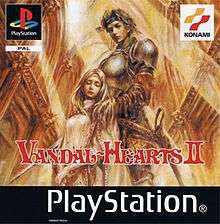Vandal Hearts II
Vandal Hearts II (ヴァンダルハーツ II 天上の門, Vandal Hearts II: Tenjo no Mon) is a tactical role-playing game for the PlayStation and the sequel to Vandal Hearts.
| Vandal Hearts II | |
|---|---|
 | |
| Developer(s) | Konami Computer Entertainment Nagoya |
| Publisher(s) | Konami |
| Producer(s) | Tōru Hagihara |
| Designer(s) | Takashi Takeda |
| Artist(s) | Shinobu Tanno |
| Composer(s) | Hiroshi Tamawari |
| Platform(s) | PlayStation |
| Release | |
| Genre(s) | Tactical role-playing |
| Mode(s) | Single-player |
Gameplay
Vandal Hearts II uses a three-map layout of an overworld map, town map and a battle map. The overworld features a basic map of the country with dots to mark the location of points of interest. Players travel over the overworld map by clicking on the points of interest and moving towards the location they have chosen.[2]
The dots on the overworld map have been divided into two sections, battle maps and town maps with all but a select few maps being re-visitable. Some locations open up only to advance the story.
Town maps are a screenshot of the town with locations of interest selected from the menu on the right of the screen, featuring the local tavern, shops and little else except where the story determines otherwise.
Vandal Hearts II boasts over 120 different weapon and armour combinations and the game features non-set classes unlike many other RPGs. Warriors can be changed to Healers without any penalties. This is achieved through the armour and weapon systems, skills must be learned through equipping weapons and earning enough points to master them, while armour determines the characters hit points and magic points as well as movement rates and defence.[3]
Combat in Vandal Hearts II is done using a new Dual-Turn System, stated as being an Active Time Battle system for tactical RPGs. The dual-turn system permits both the player and the computer to move one unit on the battlemap simultaneously.
Plot
Vandal Hearts II takes place in the country of Natra and follows the story of Joshua from childhood until adulthood, focusing his progress through the civil war that tears his home country apart. The early stages of the game introduce the hero and his childhood companions and acts as a prologue to future events in the hero's adult life.
The adult stages of the game shows the country of Natra immersed in a civil war with both warring factions having foreign backers. Joshua's renegade band of outlaws gets drawn into a plot to create a third faction to end the war and restore peace. The game has a branching storyline that can be altered by the player's dialogue choices and lead to multiple endings.[4]
Compared to the original game which had multiple, although very similar, endings depending on how well the player performed and whether or not they completed the trials of Toroah, Vandal Hearts II has four distinctly different endings and three similar endings which are determined by three choices that the player must make along the story.
Reception
Although it was praised by game critics, due to the change from the original, simple, turn based battle system to a potentially more challenging simultaneous turn battle system, Vandal Hearts II did not sell as well as its predecessor and received much backlash from fans of the first game.
Francesca Reyes reviewed the PlayStation version of the game for Next Generation, rating it three stars out of five, and stated that "With its steep learning curve, VH2 may not be ideal for novices, but because it has a strong story and clever battle features, it proves to be a great challenge for veterans."[5]
Vandal Hearts II is considered by Thegia.com to be vastly superior to its predecessor.[2]
Some criticism of Vandal Hearts II has to do with the storyline. IGN considered the story lackluster enough to not even "remember it", CNET also agrees considering the storyline to be one that most people "won't care to follow". GIA on the other hand believes that the game lacks the variety of its predecessor, with standard "kill everything" missions. Other criticisms include and have included the game's general lack of explanation towards the more complicated systems, and a translation that is described by RPGFan as "adequate but unimpressive".[6]
The controls and battle system were also criticized for being stiff and laborious and the story as long and as twisting as it was linear.[7]
On release, Famitsu magazine scored the game a 32 out of 40.[8]
References
- "Vandal Hearts II for PlayStation". GameFAQs. CBS Interactive. Retrieved June 9, 2010.
- Gaming Intelligence Agency - PlayStation - Vandal Hearts 2
- Vandal Hearts II
- Jaime. "Vandal Hearts II". RPGFan. Retrieved 2011-05-03.
- Reyes, Francesca (January 2000). "Finals". Next Generation. Vol. 3 no. 1. Imagine Media. p. 100.
- http://www.rpgfan.com/reviews/vandalhearts2/Vandal_Hearts_2-2.html
- Vandal Hearts II: Heavenly Gate - GameCritics.com
- プレイステーション - ヴァンダルハーツII ~天上の門~. Weekly Famitsu. No.915 Pt.2. Pg.10. 30 June 2006.